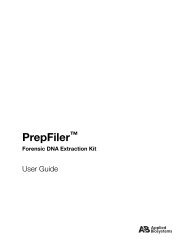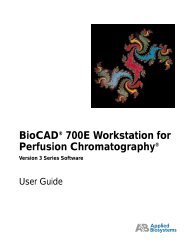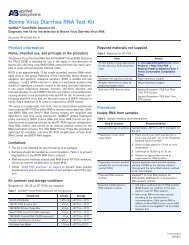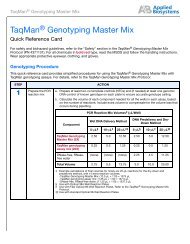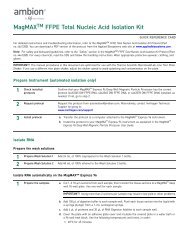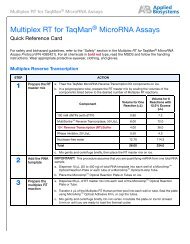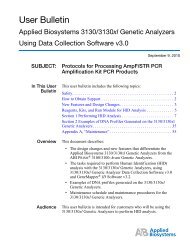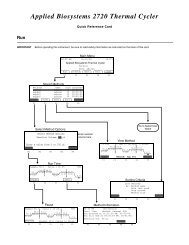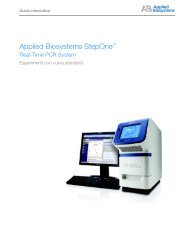AmpliTaq and AmpliTaq Gold DNA Polymerase - Applied Biosystems
AmpliTaq and AmpliTaq Gold DNA Polymerase - Applied Biosystems
AmpliTaq and AmpliTaq Gold DNA Polymerase - Applied Biosystems
Create successful ePaper yourself
Turn your PDF publications into a flip-book with our unique Google optimized e-Paper software.
Kohler, A. K., D. M. Stone, et al. (2003). "Rhodococcus equi Secreted Antigens Are Immunogenic <strong>and</strong>Stimulate a Type 1 Recall Response in the Lungs of Horses Immune to R. equi Infection." Infect.Immun. 71(11): 6329-6337.http://iai.asm.org/cgi/content/abstract/71/11/6329Rhodococcus equi is an opportunistic pathogen in immunocompromised humans <strong>and</strong> animportant primary pathogen in young horses. Although R. equi infection can produce lifethreateningpyogranulomatous pneumonia, most foals develop a protective immune responsethat lasts throughout life. The antigen targets of this protective response are currently unknown;however, Mycobacterium tuberculosis is a closely related intracellular pathogen <strong>and</strong> provides amodel system. Based on previous studies of M. tuberculosis protective antigens released intoculture filtrate supernatant (CFS), a bacterial growth system was developed for obtaining R. equiCFS antigens. Potential immunogens for prevention of equine rhodococcal pneumonia wereidentified by using immunoblots. The 48-h CFS contained five virulence-associated protein b<strong>and</strong>sthat migrated between 12 <strong>and</strong> 24 kDa <strong>and</strong> were recognized by sera from R. equi-infected foals<strong>and</strong> immune adult horses. Notably, the CFS contained the previously characterized proteinsVapC, VapD, <strong>and</strong> VapE, which are encoded by genes on the R. equi virulence plasmid. R. equiCFS was also examined for the ability to stimulate a type 1-like memory response in immunehorses. Three adult horses were challenged with virulent R. equi, <strong>and</strong> cells from thebronchoalveolar lavage fluid were recovered before <strong>and</strong> 1 week after challenge. In vitrostimulation of pulmonary T-lymphocytes with R. equi CFS resulted in significant proliferation <strong>and</strong>a significant increase in gamma interferon mRNA expression 1 week after challenge. Theseresults were consistent with a memory effector response in immune adult horses <strong>and</strong> provideevidence that R. equi CFS proteins are antigen targets in the immunoprotective response againstR. equi infection.Long, C. D., D. M. Tobiason, et al. (2003). "Low-Level Pilin Expression Allows for Substantial <strong>DNA</strong>Transformation Competence in Neisseria gonorrhoeae." Infect. Immun. 71(11): 6279-6291.http://iai.asm.org/cgi/content/abstract/71/11/6279The gonococcal pilus is a major virulence factor that has well-established roles in mediatingepithelial cell adherence <strong>and</strong> <strong>DNA</strong> transformation. Gonococci expressing four gonococcal pilinvariants with distinct piliation properties under control of the lac regulatory system were grown indifferent levels of the inducer isopropyl-{beta}-D-thiogalactopyranoside (IPTG). These pilinvariants expressed various levels of pilin message <strong>and</strong> pilin protein in response to the level ofIPTG in the growth medium. Moreover, posttranslational modifications of the variant pilin proteinswere detected, including S-pilin production <strong>and</strong> glycosylation. The ratio of the modified <strong>and</strong>unmodified pilin forms did not substantially change with different levels of pilin expression,showing that these modifications are not linked to pilin expression levels. <strong>DNA</strong> transformationcompetence was also influenced by IPTG levels in the growth medium. Substantial increases intransformation competence over an isogenic, nonpiliated mutant were observed when limitedamounts of three of the pilin variants were expressed. Immunoelectron microscopy showed thatwhen limited amounts of pilin are expressed, pili are rare <strong>and</strong> do not explain the pilin-dependenttransformation competence. This pilin-dependent transformation competence required prepilinprocessing, the outer membrane secretin PilQ, <strong>and</strong> the twitching-motility-regulating protein PilT.These requirements show that a fully functional pilus assembly apparatus is required for <strong>DNA</strong>uptake when limited pilin is produced. We conclude that the pilus assembly apparatus functionsto import <strong>DNA</strong> into the bacterial cell in a pilin-dependent manner but that extended pili are notrequired for transformation competence.



